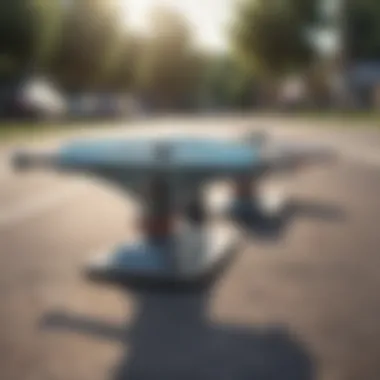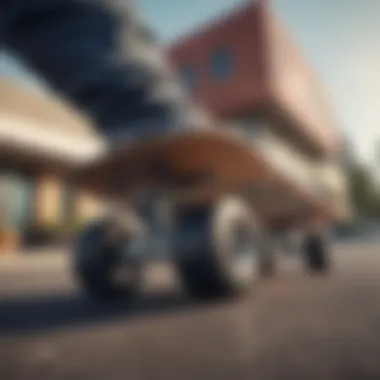Choosing the Right Truck Size for an Eight-Deck Skateboard


Intro
Choosing the right truck size for an eight-deck skateboard may seem like a minor detail, but it can make all the difference in your skating experience. Every skateboarder knows that a good setup is crucial for performance, safety, and personal style. Underestimating the impact of truck dimensions can lead to wobbling at high speeds, difficulty in landing tricks, or even premature wear of your gear. This article aims to shed light on the intricacies of selecting the appropriate truck size, ensuring both novice and seasoned skaters can find their perfect fit.
When it comes to skateboarding, truck dimensions influence not just how your board feels underfoot but also how you tackle various terrains and tricks. Whether you're cruising through the park or attempting a complex trick on a ledge, having the right truck size is essential. This guide will dig deep into dimensions, functionality, and how they align with your unique skating style.
Tricks and Techniques
For the skater, mastering tricks is as much about the board setup as it is about technique. Whether you’re doing a mellow slide or busting out an impressive heelflip, your truck size plays a pivotal role.
Mastering the Heelflip
The heelflip is a classic trick that showcases a skater's flair and precision. The height and responsiveness of your trucks can either help you achieve that perfect flick or hinder your rotation. Generally, trucks that are too wide can impede your ability to snap the board upward while executing a heelflip. Conversely, trucks that are too narrow might cause instability upon landing. Finding the right balance is key to nailing this trick.
Tips for Consistent Landings
Achieving consistent landings while skating requires both practice and the proper equipment. When it comes to trucks, opt for a size that complements your skateboard’s deck width. A well-sized truck can enhance your stability upon landing and ease your transitions between tricks. Here are some things to keep in mind:
- Pivotal Width: If your trucks are too wide, the board can feel cumbersome. If too narrow, you risk off-balance landings.
- Bushings: The softness or hardness of your bushing can influence how your board responds when you land. Choose bushings that suit your weight and personal style.
Skate Gear and Equipment
Before diving into the details of truck sizes, let’s briefly consider the broader picture of skate gear and how it all fits together.
Choosing the Right Skateboard
When selecting an eight-deck skateboard, it's crucial to consider your trucks as part of the equation. A wider deck will naturally require wider trucks for optimal performance. If you’re unsure what deck size works well, consult resources like Wikipedia or Reddit forums for discussions about preferred setups among experienced skaters.
Essential Safety Gear for Skaters
While trucks and decks are vital for performance, safety gear shouldn’t be an afterthought. Always gear up with a quality helmet, knee pads, and elbow pads. Here are some essentials:
- Helmet: Protects your head; opt for one that fits snugly
- Knee and Elbow Pads: These provide cushioning for falls; choose pads that allow for easy movement
- Wrist Guards: If you’re attempting tricks, wrist guards can be a lifesaver to prevent injuries
Remember: Safety is as essential as performance. Don’t compromise on gear!
The End
Selecting the right truck size for your eight-deck skateboard is more than just a simple choice; it’s about crafting an experience tailored to your skating style and needs. The careful consideration of dimensions and equipment can set you on a path toward improved performance. Sticking to this guide should help every skateboarder make informed decisions and feel confident on their next ride.
Understanding Skateboard Components
In the realm of skateboarding, grasping the importance of the various components can feel like deciphering a code. Yet, selecting the right parts acts like laying a solid foundation for a house. Each part plays a distinct role, all contributing to the overall functionality and feel of the skateboard. Here, we will unpack these components, focusing on their significance, benefits, and crucial considerations to bear in mind.
The Role of Trucks
Trucks are the metal parts that connect the wheels to the board. They hold a pivotal position in shaping the skating experience. Their width, height, and design directly influence turning capabilities, stability, and overall performance. If you think of the skateboard as a car, the trucks are akin to the steering, profoundly impacting how sharply and easily you navigate the streets. Cruising with a wide deck but narrow trucks is like trying to park a yacht in a garage—doesn’t quite work. Choosing the right truck size can mean the difference between a smooth ride and one that feels all over the place.
The Structure of a Skateboard
Understanding the skateboard’s structure involves more than knowing the parts; it’s about knowing how they interact to create a harmonious riding experience.
Deck


The deck, often regarded as the skateboard’s heart, provides the surface upon which the rider stands. Its width directly impacts the stability collected from the trucks. A larger deck often translates to a more stable ride, particularly for tricks that require a lower center of gravity. When selecting an eight-deck skateboard, the key characteristic to note is the width—typically between 8.0 and 8.5 inches, making it a popular choice for various styles, from street to vert skating.
A unique feature of the deck is the concave shape. This curve allows for better foot placement and greatly enhances grip during tricks. However, too steep of a concave can pose challenges for beginners, making setup feel less intuitive and more of a balancing act.
Wheels
Wheels play an essential role in how a skateboard performs on different surfaces. Generally made from urethane, the wheels' durometer (hardness) can drastically change the riding experience. Softer wheels allow for a cozy ride over rough terrain, absorbing shocks better than firmer wheels, which are often favored for smooth surfaces to attain higher speeds.
The key characteristic of wheels is their diameter, usually falling between 50mm and 60mm for street skating. Larger wheels, while they roll smoothly over cracks and bumps, can sometimes limit tricks that require height precision, like ollies and flips. Thus, choosing wheel size in relation to your skating style is vital.
Bearings
Bearings, those little round pieces that sit inside the wheels, might not get as much limelight, but their significance cannot be over emphasized. They reduce friction, allowing the wheels to spin freely. A crucial factor here is the ABEC rating. A higher rating typically indicates smoother spins, thus increasing speed. However, it’s worth noting that some riders prefer lower-rated bearings based on personal experience and style—sometimes it’s just about feel.
A special feature worth highlighting is shielded versus non-shielded bearings. Shielded bearings offer more protection against dirt and debris, prolonging their lifespan. On the flip side, non-shielded models may spin more freely, but they require more frequent maintenance. Each choice affects the overall skate setup, puzzle pieces that must fit together harmoniously.
Importance of Truck Size in Skateboarding
When it comes to skateboarding, the choice of truck size is a pivotal element that can make or break your whole experience on the board. Trucks are the crucial components that connect the wheels to the deck, providing not just stability, but also influencing how a skateboard behaves in motion. For skateboarders, the correct truck size is not just a matter of preference, but one of safety, performance, and enjoyment.
The right truck size ensures adequate weight distribution and improves your balance, which is important whether you’re cruising or performing tricks. An appropriately sized truck can also enhance your ability to execute tricks, allowing for sharper turns and better landings. Consequently, selecting the correct truck size directly relates to your skating style, making this selection process thoroughly significant.
Impact on Stability
Stability can be a game changer, especially for those who are just starting out or are transitioning to more complex maneuvers. The size of the truck affects how stable you feel on your board. When trucks are properly sized, they allow your skateboard to maintain better contact with the ground. This is important when you consider that a lot of factors — like speed and trick difficulty — can throw you off balance.
Larger trucks tend to offer more stability since they provide a broader base. However, it’s not just about having big trucks; they should be correctly matched to your deck size. Too large, and your board could feel sluggish; too small, and you risk losing control during your rides or tricks. A sweet spot exists in the middle, where you can feel secure and agile at the same time.
Influence on Maneuverability
When it comes to making swift directional changes, maneuverability plays a starring role. The relationship between truck size and how easily you can steer your skateboard is deeply intertwined. Smaller trucks generally allow for quicker turns, which can be ideal for street skating where navigating tight spaces and dodging obstacles is essential.
If you're hitting the ramps, though, you might prefer slightly larger trucks. An optimal truck size means finding a balance between enough room to rotate and grip during turns, without being so large that you can’t cut quickly when needed. Think of it like Goldilocks; the trick is in finding that “just right” feeling.
Relation to Deck Width
The width of your deck is another vital piece of the puzzle. Skateboard decks come in various widths, from narrow street decks to wide cruiser boards, and the truck size you choose should fit accordingly. The general guideline is that the width of your trucks should match or be very close to your deck width.
When trucks are correctly matched to the deck, the board feels natural almost like an extension of your feet. If they’re too wide, it can feel cumbersome, interfering with your foot placement and balance. Conversely, if they’re too narrow, there’s a risk of instability and an increased chance of wheel bite, where the wheels hit the deck and cause you to fall.
"Finding the right truck size is as personal as it gets in skateboarding; it should feel like second nature beneath your feet."
In summary, the importance of truck size in skateboarding cannot be overstated enough. It’s all about the subtle balance between stability, maneuverability, and compatibility with your deck width. Making an informed choice will not only boost your performance but will also enhance your confidence as you skate. This decision shapes your skating experience, so take your time and choose wisely.
Measuring Your Deck Width
Measuring your skateboard deck width is a pivotal step in selecting the right truck size for an eight-deck skateboard. The right width ensures not only optimal performance but also stability and control when skating. Just like trying to fit a square peg into a round hole, mismatched truck and deck sizes can lead to a less-than-ideal skating experience.
An appropriately sized truck enhances balance during tricks and provides a solid foundation for turns. Additionally, it can affect how the skateboard feels when you ride it, influencing everything from foot placement to how well you can transition from one trick to another.
When you consider your deck width, you are effectively laying the groundwork for a tailored skating setup that aligns with your individual style and preferences. By understanding this fundamental measurement, you’re on your way to ensuring that your skateboard functions effectively, enabling you to focus on perfecting those kickflips rather than battling a shaky ride.
Using Calipers for Precision


Using calipers to measure your skateboard deck width brings precision into the picture. While a tape measure works in a pinch, calipers offer a level of accuracy that's hard to beat. Here’s how you can do it:
- Position the Calipers: Open the calipers wide enough to fit over the deck and touch the edges.
- Take the Measurement: Gently close the calipers until they just touch the sides, making sure they are perpendicular to the deck.
- Read the Width: Look at the measurement scale to see the width of the deck.
This meticulous approach allows you to get an exact width, which is crucial for deciding which truck size suits your eight-deck best. Remember, every millimeter counts here, and a small oversight can lead to misalignments that might impact your ride.
Standard Deck Sizes
Understanding the standard deck sizes can further facilitate your choice when it comes to truck selection. Skateboard decks commonly come in sizes ranging from 7.5 to 8.75 inches wide. An eight-deck lies generally within this spectrum, leaning more towards the larger side. Here are some frequently acknowledged sizes and their truck pairings:
- 7.5 – 8 inches: Generally suited for smaller trucks such as Independent 139 or Tensor 5.0.
- 8 – 8.25 inches: A size that often pairs well with trucks like Independent 145 or Thunder 147.
- 8.25 to 8.75 inches: For broader decks, larger trucks such as Independent 149 or Thunder 151 may be more appropriate.
Choosing the right deck size and corresponding truck can make all the difference in your skating. Moreover, it contributes to a more cohesive skating experience, combining aesthetics with functionality. A well-suited skateboard setup provides a platform for aspiring skaters to excel and perform at their best.
Selecting the Right Truck Size for an Eight-Deck
Getting the truck size right for an eight-deck skateboard is essential for both performance and personal enjoyment. When skaters think about their setup, the size of the trucks often doesn’t get as much attention as it deserves. They're a vital link between the deck and the wheels, playing a pivotal role in how the board behaves underfoot. Choosing the right size can influence everything from stability at high speeds to the ease of turns, impacting your overall skateboarding experience.
The right truck size caters to your skating style, how you ride, and even your size and weight. If you grab the wrong dimensions, it may feel like trying to fit a square peg in a round hole; it just won't work right. In essence, the right choice will boost your confidence, allowing you to take on new tricks with ease.
General Recommendations
When selecting trucks for an eight-deck skateboard, the recommended width generally matches the deck width closely. A good rule of thumb is to aim for a truck width within half an inch of your skateboard deck. This will aid in balanced weight distribution and give skaters a good sense of control.
Here are general recommendations to consider:
- Deck Width: Measure your skateboard deck's width. Common sizes range from 7.5 to 8.5 inches.
- Truck Width: Generally, a truck's width should align closely with the deck width. So, for a deck measuring 8.0 inches, select trucks between 7.75 to 8.0 inches.
- Height of Trucks: Low, mid, and high trucks affect how your skateboarding interacts with obstacles. Low trucks lower the center of gravity, improving stability, while high trucks help with clearing ramps and other challenges.
Considerations for Different Skate Styles
Selecting truck size isn’t a one-size-fits-all scenario. Each skating style has its quirks, and knowing them can help tailor your setup better.
Street Skating
Street skating usually emphasizes technical maneuvers, often in urban settings. With this form, skaters often prefer a more responsive feel. Trucks that are slightly narrower can aid in quick turns and flip tricks, making skating more agile.
- Key Characteristic: Precision and response are crucial here.
- Benefits: Narrower trucks give better control for flip tricks, while keeping stability.
- Disadvantages: Can feel less stable at high speeds due to reduced width.
Vert Riding
When dealing with vert riding, the focus shifts to balance and stability during big airs and transitions. Wider trucks offer a solid platform that can handle the pressures of vert skating. They provide better grip, making it easier to stay grounded during high-speed turns.
- Key Characteristic: Emphasis on support.
- Benefits: Wider trucks improve balance and maintain control when riding transitions.
- Disadvantages: May be a bit cumbersome for tricks requiring quick footwork.
Freestyle
Freestyle skating relies on creativity and often employs tricks that require a different approach to truck size. Typically, skaters may favor a lower profile truck as it opens up the board for tricks that flip and spin more efficiently.
- Key Characteristic: Versatility in tricks.
- Benefits: Provides a better feel for the board, which is key in freestyle.
- Disadvantages: Can lose some stability, mainly if the skater is unaccustomed to a lower setup.
Weight and Aggressiveness of Skater
Every skater is unique, and body weight plays its role in the selection process. A heavier skater may benefit from sturdier trucks that can handle additional strain without bending. In contrast, a lighter skater should opt for lighter models that allow for easier maneuverability without feeling unwieldy.


Moreover, the aggressiveness of a skater affects truck choice. If someone is leaping and landing hard consistently, sturdier trucks that can withstand impacts would be beneficial. Likewise, more gentle riders may want to focus on responsive options but do not require the added bulk of heavy-duty trucks.
In summary, understanding the relationship between your style and your trucking choice can significantly enhance your skateboarding adventure. The right equipment allows you to explore various terrains and techniques, enabling you to skate at your highest potential. When you get this balanced selection right, you put yourself in a prime position to progress and enjoy every ride.
Popular Truck Brands and Models
When picking the right truck size for an eight-deck skateboard, it's not just about measurements or what looks cool. The brand you choose can really shape your skating experience. Renowned brands have built their reputations on quality, performance, and innovation, making it easier for skaters to select equipment that suits their style and needs. By examining popular brands like Independent, Tensor, and Thunder, we can see the unique characteristics that they bring to the table, which can significantly impact performance and satisfaction in skateboarding.
Overview of Key Brands
Independent
Independent trucks have long held a revered position in the skateboarding community. Known for their durability, they are often favored by those who skate aggressively. The key characteristic of Independent trucks is their sturdiness. They are designed to withstand tough terrain, making them a solid choice for street skating and vert riding alike.
One unique feature of Independent trucks is their geometry, which enhances stability during tricks. This feature allows skaters to maintain balance, even when launching off ramps or grinding rails. The downside might be their weight; being robust means they can feel a bit heavier compared to lighter models. However, many skaters find the trade-off worth it because of the added confidence and control.
Tensor
In contrast to Independent, Tensor focuses on producing lighter trucks without sacrificing performance. The key selling point of Tensor trucks is their aluminum construction which provides strength but keeps the weight down, allowing for quick movements and flips. This makes them particularly appealing for skaters who prioritize agility.
A unique element of Tensor trucks is their hollow axle design. This feature not only reduces weight but also enhances reactivity, making it easier to perform intricate tricks. While they might not be as robust as some heavier brands, many find their balance between lightness and performance suits street skating perfectly. However, some users feel they aren't as sturdy for heavier impacts compared to Independent.
Thunder
Thunder trucks are known for their balance of weight and strength. They are a popular choice among skaters who enjoy both street and park skating. The key characteristic of Thunder trucks is their responsive turning, which significantly aids in maneuverability. This makes it easier for skaters to navigate and perform tricks with finesse.
One of Thunder's unique features is their low-profile design, which lowers the center of gravity, increasing stability while skating. This can be a massive advantage in executing flips or technical tricks where balance is paramount. However, some may find that the lighter build compromises durability over time, especially under rigorous conditions.
Model Specifications
When deciding on the right truck, the specifications also play a crucial role. These include considerations such as width, height, weight, and generally the compatibility with other skateboard components. Here are some valuable insights:
- Width: Ensure the truck width matches the deck width for optimal performance.
- Height: Higher trucks are better suited for bigger wheels, while lower trucks provide more stability for tricks.
- Weight: Lighter trucks offer increased agility, while heavier options provide robustness for rough skating.
Ultimately, selecting the right truck involves weighing both personal preferences and the specific demands of your skate style. By keeping these factors in mind, skaters can ensure that they choose a truck that enhances their overall skating experience.
Final Thoughts on Truck Selection
Selecting the right truck size for an eight-deck skateboard is not just a technical decision; it shapes the entire skateboarding experience. Your choice of trucks can dictate how well you perform daring tricks, navigate technical spots, or even just cruise around the neighborhood. An optimal truck setup leads to a balanced board that fits your skate style, improving your overall confidence and enjoyment.
When choosing trucks, a careful consideration of your skating habits is paramount. Do you prefer the grind-heavy approach of street skating or the air dynamics found in vert riding? Recognizing your style influences not just your truck size but also your choice of model and brand. Furthermore, adequate understanding of truck specifications can streamline your decisions and avoid the common pitfalls many beginners face, such as ending up with too wide or too narrow trucks.
Benefits of selecting the appropriate truck size include:
- Enhanced Stability: Better suited trucks provide more stability, particularly useful during high-speed maneuvers.
- Improved Maneuverability: Tailored truck sizes can enhance your turning capabilities, allowing for more dynamic skating.
- Customized Setup: Individual preferences are catered to, ensuring you enjoy the ride and stay comfortable with your gear.
- Longevity of Equipment: The right fit can prevent undue wear and tear on your skateboard, thereby extending its life.
The Role of Trial and Error
One of the most pragmatic approaches to fine-tuning your truck selection is acknowledging the trial and error. Skateboarding is personal; what works for someone else may not suit your needs, and that’s perfectly fine. Testing different sizes can lead to surprising discoveries about your riding style. When you switch trucks and feel that responsive grip during a trick, or notice the stability while cruising, you might just hit jackpot on your preferences.
Balancing Your Setup
Finally, balancing the entire skate setup goes beyond selecting truck size. Every element interacts, from the deck width to wheel durometer, affecting your entire skating experience. As such, consider how each aspect comes into play:
- Deck Width & Truck Size: Ensuring compatibility between your deck and truck size can create a seamless flow and functionality.
- Wheels and Bearings: Matching your wheels and bearings to your truck setup is vital. For example, wider trucks typically pair well with larger wheels for added stability.
- Skater Weight: More weight might necessitate wider trucks for better load distribution.
Ultimately, selecting truck size and making all your choices demands thoughtful consideration. Making adjustments according to firsthand experience will result in a skateboard that reflects your unique style and enhances every ride.
"In the world of skateboarding, your board is an extension of you. Choose wisely, and it will take you places."
The journey to finding the ideal truck size is one of experimentation and personalization. As you seek the right balance, don't hesitate to tweak your setup until it feels just right. This process is integral to not only improving your skills but also enjoying the ride.



